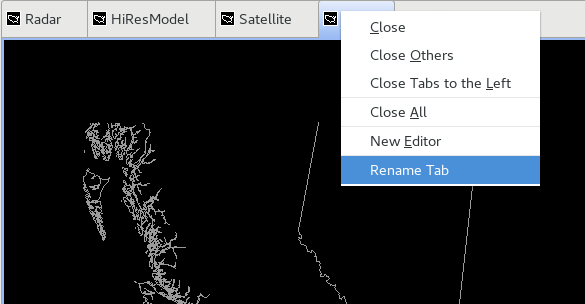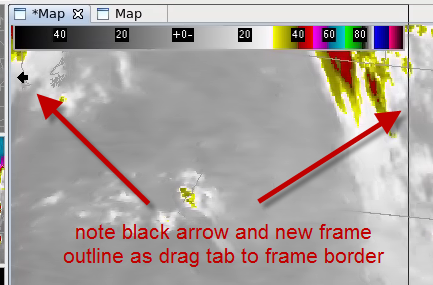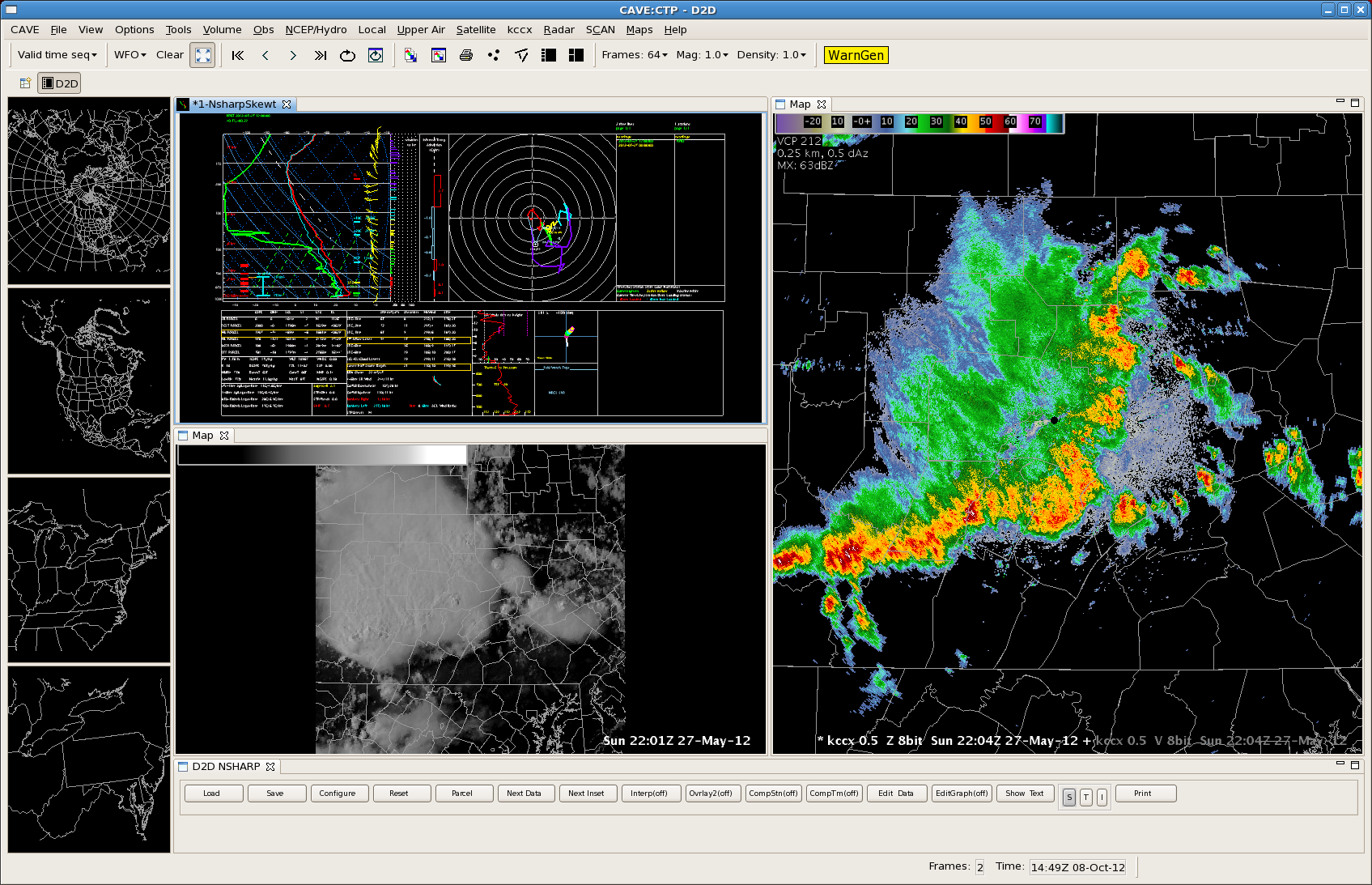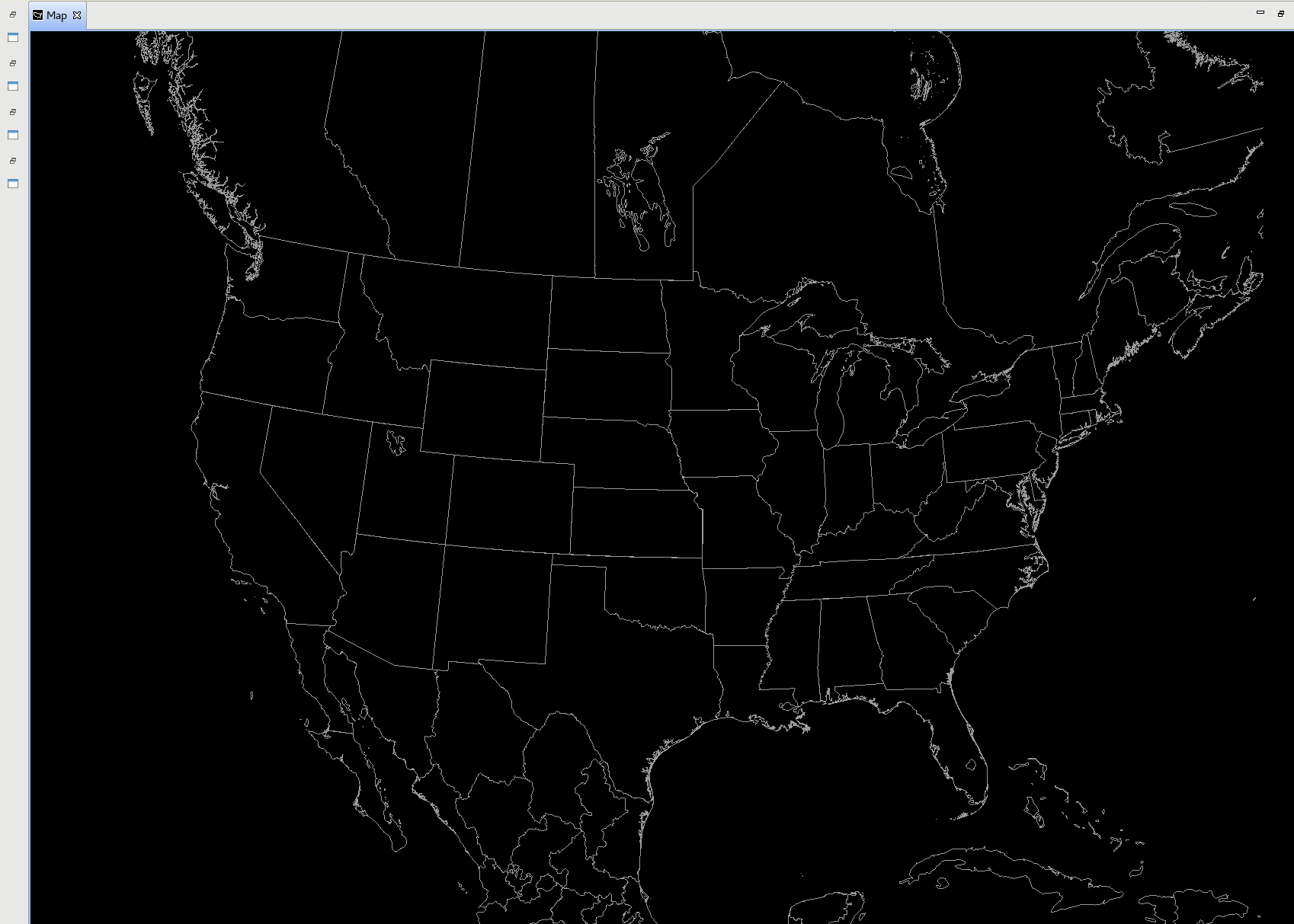Loading, Arranging, Renaming, and Unloading Additional Map Editors - OCLO
- 01- CAVE Fundamentals
- Setting the Time Match Basis of a Product
- Loading and Toggling Radar Graphic Overlay Products
- Overlaying CAPE on a Base Reflectivity Product
- Overlaying a Surface Plot on a Base Reflectivity Product
- Overlaying Model Image on Radar and Satellite
- Transferring Screen Products Between the Main Display Pane and Side Panes
- Loading, Arranging, Renaming, and Unloading Additional Map Editors
- Zooming In or Out of a Product View
- Panning a Zoomed-In Image in the Main Display Panel
- Switching the Color Table for a Radar Image Product
- Editing the Current Color Table
- Unload a Map Overlay
- Loading a Map Overlay
- Changing a Map's Display Characteristics
- Loading the Alphanumeric Information for a VWP Product
- Using the AFOS Browser to Load an Area Forecast Discussion
- Move and Adjust Width of AlertViz
- Launch Text Section Log and Display Detailed View
- Loading and Using the AWIPS Data Monitor
- Blinking a Range of Data Values
- Printing the Contents of the Main Display Panel
- Creating a Screen Capture of the Main Display Panel
- Saving/Loading Editor and Perspective Displays
- 02- D2D Fundamentals
- Create a New Procedure
- Opening an Existing Procedure
- Load a Product from the Product Inventory
- Clearing a Product from the Main Display Panel
- Manually Toggling and Looping Single Elevation Angle Products in Time
- Create an Image Combination and Toggle Between the Images
- Use Panel Combo Rotate and All Panel Sample on Dual Pol
- 03- D2D Radar
- Load Radar Products for Single Radar and Radar/MRMS Mosaics
- Toggling Product Displays
- Viewing Radar Cursor Readout Information
- Loading Products into Four-Panel Displays
- Submit an OTR for a Three Hour Precip (THP) Product
- Build a New Request in the RMR GUI
- Managing Active Requests in the RMR GUI
- Loading an All Tilts Product into the Main Display Panel
- Load a VWP Hodograph
- Load a Vertical Reflectivity Cross-Section Image Product Using the Volume Browser
- Load a Horizontal Reflectivity Cross-Section Image Product Using the Volume Browser
- 04- D2D Satellite
- 05- D2D Upper Air
- Load NSHARP into your CAVE Display
- Change NSHARP Configurations
- Cycling Through the Tables
- Toggling Display Insets
- Toggling Graphs and Statistics
- Interact with the Inventory in the D2D Skewt Standard Screen Configuration and Use Keyboard Shortcuts
- Configuring a Sounding and Hodograph Display
- Changing the Parcel Lifting Method
- Display Multiple Active Soundings
- 06- D2D Tools
- 07- D2D Applications
- Issue A New Severe Thunderstorm Warning
- Follow Up a Severe Thunderstorm Warning with a Severe Weather Statement
- Loading an FFMP Basin Trend Graph and Downstream Basin Trace
- Assessing QPE, Ratio, and Diff
- Closing the FFMP Table
- Loading the FFMP Basin Table
- Loading a SCAN Storm Cells Table
- Interacting with the SCAN Storm Cells Table
- Launching the MESO and TVS Tables
- Closing the SCAN Cell Table
Purpose:
This task describes loading/unloading additional map editors, arranging map editors, and minimizing/maximizing editors.Tasks:
- From the Satellite menu, select IR Window.
- Create a new Map Editor using one of the following methods:
- Method 1: Pop-up menu from right-clicking on the existing Map Editor icon.
- Right-click on the Map Editor tab at the top of the main display pane and select New Editor.

- Right-click on the Map Editor tab at the top of the main display pane and select New Editor.
- Method 2: Select from CAVE menu.
- From the CAVE menu, select New, then select Editor.
- Method 1: Pop-up menu from right-clicking on the existing Map Editor icon.
- Right-click and hold on each Map Editor you have added and select Rename Tab. Type the name that you would like to appear in the Tab (e.g. Upper Air).

- Arrange Map Editors within the main display.
- Reorder the Map Editors with a left-click and hold mouse maneuver on the tab and moving it left or right.
- While moving, the mouse pointer will highlight a vertical bar to indicate the position of the tab.
- Drag and drop the Map Editors to split the main display with multiple editors.
- Left-click and hold on the Map Editor and drag it to the left or right borders of the main display.
- When reaching the border of the main display, a black outline (or white if over darker shades) will appear where the map editor will be placed in the main display. The action splits the existing window with both editors taking up one half of the existing space.

- When reaching the border of the main display, a black outline (or white if over darker shades) will appear where the map editor will be placed in the main display. The action splits the existing window with both editors taking up one half of the existing space.
- Add another map editor and move one to the bottom or top border of the main display. An example main display with multiple Map Editors is shown below with the main display split by three Map Editors.

- Left-click and hold on the Map Editor and drag it to the left or right borders of the main display.
- Reorder the Map Editors with a left-click and hold mouse maneuver on the tab and moving it left or right.
- Swap panes with a side editor by right-clicking on the side pane and note only one editor swaps in the main pane.
- Close a Map Editor using one of the following methods:
- Method 1: Left-click on the X on the editor tab.
- Method 2: Select from the Map Editor pop-up menu.
- Right-click and hold on the editor tab and select Close.
- There is also the option of Close Others, which will close all tabs but the one selected, and Close All.
- There also is an option to Close Tabs to the Right (or Left).
- If all editors are removed you can add a new editor from the CAVE menu and New submenu.
- Right-click and hold on the editor tab and select Close.
- Double-click anywhere in the Map Editor tab space, including the tab "Map" itself. This collapses the side panes and gives a larger map editor space to allow for displaying multi-panel layouts.

- Task Complete!



